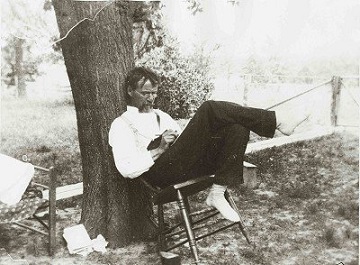“The creative scientist has much in common with the artist and the poet. Logical thinking and an analytical ability are necessary attributes to a scientist, but they are far from sufficient for creative work. Those insights in science which have led to a breakthrough were not logically derived from pre-existing knowledge; the creative processes on which the progress of science is based operate on the level of the subconscious.” (Leó Szilárd)
 Osteopathy originated near the end of the 19th century, thanks to the insight of Andrew Taylor Still, a former frontier ‘physician’ during the American Civil War, who had observed that the human body has much in common with a ‘machine’. This analogy demonstrated a new understanding of the organism, which should work properly if it id bio-mechanically sound.
Osteopathy originated near the end of the 19th century, thanks to the insight of Andrew Taylor Still, a former frontier ‘physician’ during the American Civil War, who had observed that the human body has much in common with a ‘machine’. This analogy demonstrated a new understanding of the organism, which should work properly if it id bio-mechanically sound.
It is not just a different kind of manual medicine, but it is founded upon a philosophy and a comprehension that the human body/mind organism has a powerful, innate capacity for self-healing that can be mobilized and directed by structural correction. It is a therapeutic system based upon the re-establishment of structural integrity, and the normalization of nerve supply, blood supply and lymphatic flow throughout the body.
Osteopathy, as described by Still, is both bio-mechanic and vitalistic. Bio-mechanic in the sense that a deep knowledge of anatomical relations informs successful diagnosis and treatment; and vitalistic in the sense that the body is assumed to have inherent healing capacities that are mediated through the blood and the nervous system. This capacity for self-healing may, according to Osteopathic principles, be diminished or disturbed by the presence of structural restrictions, subluxations, or lesions, and improved or restored through structural correction.
In its highest skill, it represents far more than a simple bio-mechanic adjustment useful for the treatment of back pain and stiff necks. The body is perceived as a whole, a sort of a “holographic integrum”, and dysfunction in any given part may subtly influence activity in other areas. The purpose of Osteopathic evaluation is to enable the Osteopath to identify structural problems that may be influencing joint movement, circulation of the blood, or nerve supply. Through corrective adjustment, the very body’s self-healing capacity is maximized and enabled to do its own work without obstacle.
For J.M. Littlejohn, “the science and system of therapeutics we call Osteopathy constitutes the application of physical treatment for conversion into a physiological process within the body.” One of the particularities of Osteopathy is that its efforts are focused to evaluate and treat the whole body, on a structural and functional basis, offering a different dimension in medical care, as currently known.
In a certain way, Osteopathy reflects the Hippocratic approach of the patient and the disease. The ancient discussion that argues whether the physician should focus on the patient or the patient’s disease comes from the beginning of medical history, when the Hippocratic philosophy centered on the patient, while the opponent Cnidian philosophy focused on the disease.
It is worth noting that the role of the osteopath includes also those of an educator and a facilitator. Educator, as he/she should teach patients how to manage their own health; give the right information for prevention and maintenance of health, with the following purposes: 1. Mental Health 2. Physical Health 3. Nutrition Health; and lastly, make the patient free of himself, so that he can stand alone. Facilitator, because we are not more than an instrument of the Vis Medicatrix Naturae, which helps the body/mind organism subjected to our care and which, at that very moment, is in a stall.
What about science
“What we observe is not nature itself, but nature exposed to our method of questioning.” (W.K. Heisenberg)
 A current definition of science could be that of a system of knowledge, obtained by methodical processes and by well-ordered research activity, in order to describe reality in an objective manner, and to define the laws that govern the frequency of a given phenomenon. Some key elements of the scientific method can be the experimental observation of an event, the formulation of a general assumption under which this event occurs, and the possibility of testing the hypothesis through subsequent observations. That is, the predictability and repeatability of an event.
A current definition of science could be that of a system of knowledge, obtained by methodical processes and by well-ordered research activity, in order to describe reality in an objective manner, and to define the laws that govern the frequency of a given phenomenon. Some key elements of the scientific method can be the experimental observation of an event, the formulation of a general assumption under which this event occurs, and the possibility of testing the hypothesis through subsequent observations. That is, the predictability and repeatability of an event.
Usually people believe that only science, representative of an objective and mathematical point of view, can tell us the functioning of the phenomena of the world; the truth is considered to be always on its side and, in this conception, only the scientific community has the monopoly of knowledge. However, the distinction, many times attempted, between what should be considered to be scientific and what, conversely, should not, has often a foundation based on fideistic motivations instead of actual rational considerations. In the words of Shepherd, we can say that we are facing with a “Scientific Mythod” rather than a Scientific Method[1].
It is prudent to keep in mind that in science we have to do with a human mediator, a subjective one, that provides a scientific method and then interprets it. In addition, science itself cannot be the only plausible explanation for all phenomena, but is simply a key to interpreting the knowledge. Likewise, various aspects of reality – for example the existence of conscience and subconscious, empathy and universal feelings as love – are poorly demonstrable by science.
The belief that reality can be grasped only by science is strong enough to transform science itself, as would say the philosopher Feyerabend[2], in a sort of religion, in which people trust in the objectivity of science almost in a religious way: “In society at large the judgment of the scientist is received with the same reverence as the judgment of bishops and cardinals was accepted not too long ago.”
Indeed, it is possible to identify, in the scientific field, a sort of system of beliefs, expressed through the “theological virtues” such as faith and hope. The scientist, in fact, starts his investigation from one hypothesis, i.e., from one of his “faith”. And besides the natural thirst of man to know, “hope” can be considered one fundamental stimulus that leads to deal with science and for which, for example, one justifies countless scientific experiments. Another interesting aspect refers to the demands of “salvation” of science, without which it would lose its attractiveness at the eyes of the public. For last, in extreme cases, science can even get to the point of fanaticism.
These different facets, mentioned above, are most evident in medicine, which will try in all ways to move as far as possible the moment one will have to contemplate suffering and death, neglecting the importance of the quality of life with respect to its duration.
In the current societies of the western world “the deadly disease has become a shameful, terrifying event”. Serious illness and death are “hidden inasmuch today people usually die isolated in hospitals, watched over by professionals, visited by family members only during the authorized visit’s hours (…) furthermore, instead of being part of the existence, of the life cycle, those have become extraneous. While death, in the past, was lived socially, now it is a solitary individual phenomenon. (…) the uncertainty of life is no longer lived with the same intensity and people claim the moral right to their own part in the national average of longevity.[3]”
Under this demand science makes its offerings, so there is what the contemporary medicine is all about. Yes we are living longer, but medical-ized in all the ways, to keep high the consumerism. As Maggi observes, “the image of an always winning medicine, able to solve any problem, if not today for sure tomorrow, attracts patients, public and private funding and moves one of the largest and most powerful industrial sectors as that of pharmaceutical and bio-medical technologies.[4]”
The scientific medicine
 If it is correct the conviction that medicine, in general, should not ignore the latest technologies and scientific discoveries, related to the detection of clinical and instrumental data and therapeutic applications, it neglects the fact that the “medical art” cannot be simply reduced to the application of techniques and technologies, encoded in a medical-scientific practice “apparently rigorous”. Or else, it is easy to lose “the centrality of human being (…) transformed more like a walk-on that appears on a stage dominated by its technological tools, the maximum expression of the long-awaited ‘objectivity’. And this forest of technological ‘prosthesis’ that science has slowly sandwiched between its operators and the world of phenomena, ended to swap the reality with the images that our tools refer us.[5]”
If it is correct the conviction that medicine, in general, should not ignore the latest technologies and scientific discoveries, related to the detection of clinical and instrumental data and therapeutic applications, it neglects the fact that the “medical art” cannot be simply reduced to the application of techniques and technologies, encoded in a medical-scientific practice “apparently rigorous”. Or else, it is easy to lose “the centrality of human being (…) transformed more like a walk-on that appears on a stage dominated by its technological tools, the maximum expression of the long-awaited ‘objectivity’. And this forest of technological ‘prosthesis’ that science has slowly sandwiched between its operators and the world of phenomena, ended to swap the reality with the images that our tools refer us.[5]”
One of the theoretical bases, on which medicine lies upon, is statistics, which we refer to illustrate some of the mechanisms that govern scientific methods. Statistics is a discipline that studies collective phenomena, both natural and social, using mathematical methods, in order to draw explanatory models. Aim of statistics is to collect, analyze, and interpret data extracted from a large population. At the base of these actions is worthy of note the theory of the calculus of probability; and, when it comes to probability, it is always covered a number of errors of judgment or some paradoxes, because in this model of statistics nothing is absolute.
Using statistical methods, it is possible to define, in medicine, different parameters, a trivial example is the evaluation of the blood components, which establishes whether a blood test is normal or altered, based upon a predetermined average in sampling techniques. At this point, some questions arise: does the definition of “normality” corresponds to reality? And who determines the quantitative values – the excess or deficiency[6] – for which an individual can be considered healthy or sick?
Certainly, the laboratory (as well as other tools and application techniques available in medicine), is able of giving the correct values with very low margin of error, lying upon the statistical analysis of specific and isolated data. Yet this conception of infallibility of technical and objective instruments shows us that medical science identifies the human body as an object, consisting of a large amount of systems and rules, the observance of which ensures the right functioning, while the disease is evaluated in strictly quantitative terms.
However, this view seems ignore the subjective experience of being “healthy” or “ill”. It is important to remember that in history, medicine originated from the personal “feeling bad” experience: “in questions of biology it is pathos which conditions the logos because it calls it forth. It is the abnormal which arouses theoretical interest in the normal. Norms are recognized as such only when they are broken. Functions are revealed only when they fail[7]”. In brief, “first of all, because men feel sick that there is a medicine. It is only secondarily – that men know what they are sick of[8]”.
One of the possible consequences of the “reckless and irresponsible use of statistics” is to serve as “a further step toward the shrinking medicine’s and physician’s responsibilities towards the ‘person-patient’, his individuality, in the name of a non-existent scientific rigor and objectivity that do not offer any serious guarantee, nor can offer. In the name of an ideal of precision and accuracy, that does not exist even in the ‘Exact’ sciences, there is a risk of trampling special situations within a general attitude, in which healing and health in turn, become a mere statistic event.[9]”
Therefore, it is not desirable, according to an arithmetical mean, to establish normality and abnormality in an absolutely objective sense. The French philosopher Canguilhem has demonstrated that the identification of normality is often arbitrary and meaningless, because it does not allow, in a clear way, to determine whether an individual, in its corporeity, is sick or not. The human being, in short, is something more than a collection of constituents subjected to a numerical examination.
The definition of terms as normal, anomaly and pathological[10] deeply marks western medical knowledge, so much to declare sick someone, without that it is aware of, and to affect significantly the subjective values of the terms disease, health and healing. Conversely, the distinction between normal and pathological lies precisely in the subjective experience of the sick individual – who lives in relation to a well-delimited social and environmental condition.
Therefore, the starting point of medicine, dwelling in the suffering of the individual, cannot come exclusively from the exam of specific organs, separated from the body and studied in lessons of anatomy, in which the human body is dissected, examined under the microscope and intended according to the laws of physics and biology – the human body is, in reality, a set of vital processes. For Canguilhem, man is not made of separate parts, but rather is a “mindful body” – a form of embodiment-experience – anticipating the ethno-anthropological concept of embodiment, which investigates the uninterrupted process that leads to somatize culture through one’s own body. To help to restore the normal condition of this mindful body, we need to help nature “by imitating its processes which are positive in themselves.[11]”
According to the philosopher and American doctor Pellegrino[12], the peculiarity of medicine lies in the fact that it “calls upon insights, knowledge, skills, and techniques from science, art, and the humanities, but for a distinctive and defined end [healing this patient] that is not the end of any of these other disciplines.” Besides, medical characters are also human beings, inserted in a human context.
The French biologist Jacques Monod[13] has brought to light a “profound epistemological contradiction” about the arrangement of biology within the frame of objectivist scientific thought, affirming that “Objectivity nevertheless obliges us to recognize the teleonomic[14] character of living organisms, to admit that in their structure and performance they act projectively — realize and pursue a purpose. Here therefore, at least in appearance, lies a profound epistemological contradiction. In fact the central problem of biology lies with this very contradiction, which, if it is only apparent, must be resolved; or else proven to be utterly insoluble, if that should turn out indeed to be the case.”
In close analogy with medicine, to impose a character of objectivity to biology implies the negligence of any idea of subjectivity, of planning, of a program of life; these are all, actually, the key concepts of biology, that highlight the fundamental principle, i.e. life is dynamis, namely, in constant motion.
Some considerations on science
“Medicine is a science of uncertainty and an art of probability.” (Sir William Osler)
 The great philosopher Plato, unlike the current thinking, did not make difference between Art and Science. For Plato the art is that one of the reasoning, like the philosophy in its highest degree, i.e. the dialectic; art is also medicine and poetry, politics and war, respect and justice, all elements of the civilization.
The great philosopher Plato, unlike the current thinking, did not make difference between Art and Science. For Plato the art is that one of the reasoning, like the philosophy in its highest degree, i.e. the dialectic; art is also medicine and poetry, politics and war, respect and justice, all elements of the civilization.
We note, by the way, that all kinds of arts goes as follows: they move from a system of abstract-theoretical rules by particular techniques, to the creation of a human activity. Therefore, Plato puts art in the role of that discipline that embraces every ordered human activity (science included).
Usually, one conceives science and art as two completely opposite visions of the world. Science is “viewed as the kingdom of the “objective” certainties and as timely application of method; and art as the place of subjective radical singularity of human feeling and as pure creativity.[15]” In contrast, “we can discover interesting connections from the point of view of common cognitive strategies, and, above all, try to force the dichotomy and disclose rather the fractals thin borders, revealing their common nature of ‘languages’ to understand the world. In particular, it is useful to avoid any ideological vision of science and to bring it to its natural status of methodological craft that makes tools to work for specific problems.[16]”
Science can, therefore, be compared to a masterpiece of art: “the scientific theories, like the masterpiece of art, are chosen perspectives on the world, that interpret it in accord with cognitive strategies suggested by the problem under investigation itself, by the ‘subject’ that we want to represent.[17]”
Feyerabend, a student of Wittgenstein and Popper, declares: “science in its best aspects, i.e. science which is practiced by our great scientists, is a profession or an art, but not a science in the sense of a ‘rational’ achievement that obeys to mutable criteria of reason and that uses well-defined, stable, objective concepts, and therefore independent from practice”. He also declares that “science like something opposed to the human sciences exists only in the dreams of the philosophers” and, finally, that “good science is an art, not a science.[18]”
It is interesting to note that the philosopher considers science, essentially, an ‘impure’ activity, because it has been produced, analyzed and interpreted through the lens of historical-cultural and social foundations, which are very closely related to the temporal and spatial dimension; it implies, therefore, that the principles, the methods, and the scientific purposes, in reality, are not so abstract and impartial as they would like, but rather are predetermined by real and practical factors, often ideological and subjected to changes.
Therefore, it becomes evident that “science, not unlike any other human activity, makes from time to time its instruments. The methodological box of conceptual tools used by scientists is always open and mutable, and has an adaptive character, centered on the problem, a situation where creativity plays a key role.[19]”
It is a well-known fact that the greatest scientific discoveries have been possible thanks to the intuition, intended as an innate knowledge, and to the lateral thinking[20], non-conventional, reflexive, which breaks the preconceptions in a creative and not logical way, dealing with the problem from a different angle, not the one dictated by costume, society and historical time.
Today, even if the “scientific medicine”, rich of vanguard technology, has “eliminated many diseases, for those who have no remedy – such as, for example, ‘rheumatism’, dermatosis and several so-called psychosomatic disorders – psychological factors are involved and therefore it fits very well the so-called parallel medicines[21]”, in which several factors come into play, including empirical knowledge and interventions that take into account even psychosomatic and psychopathological aspects of illness.
We are able to identify, in the most recent researches in several areas (neurophysiological, psychological, biological, linguistic, Psychoneuroendocrine Immunology) an effort to relate various concepts and ideas in a broader and complex framework. Concepts in increasing development, such as mindfulness, embodiment, extracellular matrix regulatory system, biochemical individuality (related to Functional Medicine), the communication therapist-patient, language in all its shades (verbal and non-verbal, Semantics, NLP, Hypnosis, etc.), the intention in the therapy and other subjective aspects beyond the conscious mind, those are all new elements on which rely on, for studying some phenomena in the osteopathic field.
Particularly, it is interesting the role of intention in the therapy, which has been known for millennia in Traditional Chinese Medicine with the phrase “Yong Yi Ling Qi”, i.e. “to use the mind-intent to direct the qi” (the Healing Energy). Consider, too, one of the theories of quantum mechanics, which contemplates a subjective reality and also the influence of the observer on the studied object, expressing a completely unusual perspective of the researcher.
Regarding a qualitative approach of science, we can mention the considerations of René Thom, known contemporary mathematical, creator of the Theory of Catastrophes:
As far as life and social sciences are concerned, (…) I have reached the conviction that there are simulating structures of all natural external forces at the very heart of the genetic endowment of our species, at the unassailable depth of the Heraclitean logos of our soul, and that these structures are ready to go into action whenever necessary. The old idea of Man, the microcosm, mirroring World, the macrocosm, retains all its force. Those who know the man will now the universe[22].
From this extract we can deduce one of the key thoughts that underlies his research: the complementarity of natural phenomena and social phenomena, i.e. the belief that the dynamic structures, which govern the natural evolution, are virtually identical to those that govern the evolution of man.
Medicine: art and science
“Medicine is the most humane of sciences, the most empiric of arts, and the most scientific of humanities.” (E.D. Pellegrino)According to Hippocrates, medicine was considered more an art than a science, the latter of which must meet the expectations that arise from its own procedural capacities. The artistic aspect, instead, presumes a be able to do by direct experience and by the use of techniques to better operate. In this context, medicine is also a technique, whose objective is to re-establish the condition of health, namely the allostasis, understood as a new balance to another level[23].
 As stated by Grmek, “medicine has never been nor is it now a science. The Greeks called it iatrikè techne, not epistème, considering it as a kind of craft activity, which operates the synthesis between science, technique and art. In fact, medicine may not be a science, because science does not involve the practical application of knowledge. Physicians should also act even not knowing all the elements of the problem[24].” We can add that, at the beginning of the history of medicine, it had operated even without having a “scientifically proved” foundation.
As stated by Grmek, “medicine has never been nor is it now a science. The Greeks called it iatrikè techne, not epistème, considering it as a kind of craft activity, which operates the synthesis between science, technique and art. In fact, medicine may not be a science, because science does not involve the practical application of knowledge. Physicians should also act even not knowing all the elements of the problem[24].” We can add that, at the beginning of the history of medicine, it had operated even without having a “scientifically proved” foundation.
Hence, medicine is not only a science like chemistry or physics, but it is also a practice, an Ars Vivendi, which makes use of other sciences of various extractions[25]. The medical art expresses a modus operandi that places in the center of its attention the subject as it is, and provides assistance in relation to its possibility, through an objective and experiential action. The artistic feature of medicine contemplates a “partial improvement”, the presence of a “precarious health” and the ”coexistence of suffering and disease”. We can, therefore, presume that medicine, in the broad sense of the term, can also be considered an art, “the synthetic product of various components: scientific, industrial, political, cultural, interpersonal, and so is its ‘object’”[26].
Science is characterized for having an object of investigation; as a result, medicine may not be regarded as science because it does not have an object on which investigate, but a subject with whom one interacts through a patient-therapist relationship. Because it lacks of object, medicine is a practice closer to philosophy than science. The “interweaving between philosophy and medicine indelibly marks the early stages of the two disciplines in the East and West.[27]” Not a case, Heidegger poses as foundation of ontology the care (Sorge) of existence.
The medical art could be considered, possibly, even at the origin of western philosophy: Hippocrates and others preceded Plato and Aristotle in the investigation of nature, before they could exercise their own theoretical reflections. Moreover, Pellegrino affirmed that there are two fundamental factors confirming that philosophy of medicine can be considered a distinct discipline. First, he defends that medicine is not simply the summation of the individual disciplines that comprise it. “The philosophy of medicine, therefore is not synonymous with the philosophy of biology, literature, history, or sociology, though each may contribute to medicine’s specific enterprise”. The second is that philosophy of medicine is diverse from medicine itself. Philosophy of medicine, although investigating topics that intersect with medicine, treats medicine as its subject matter, and “seeks to understand and define the conceptual substrata of medical phenomena”[28].
Even if osteopathic education was influenced by scientific medical models of the beginning of the twentieth century, what particularly differentiates it from conventional medicine, in addition to the “use of specific manual techniques for diagnosis and treatment together with an umbilical-like attachment to an earlier era at the dawn of Osteopathy”, is “philosophy”, which “has been claimed as a differentiator of the key difference in practice from medicine”[29].
Those who strongly defend the scientific methods applied to medicine, can argue that it has actually an object: to one side represented by the individual itself; on the other side, by a morbid entity, “cause” of diseases, which belongs to the pathophysiology. What if we considered the individual not the object of science, but the subject of his own personal history? From this point of view, we can look at a certain person as someone who evolves over time, and is in constant transformation, as a “flowing river”.
As we know, the human body is composed of around 80 trillion of cells, which every 7 years complete a turnover; in addition there are even 420 trillion of other microorganisms living in the body. Furthermore, the body/mind organism is in reciprocal relationship with the surrounding environment, and often this aspect is underestimated and misunderstood concerning health and disease, forgetting the basic principles of biology, in which the cell specifies itself depending on the action of the environment where it develops. From here, we can also depict an individual disease as an expression of a general ailment, in the social sphere.
It is significant a careful examination of the English words “disease”, “illness”, “sickness”[30], each one indicating the same event, but from different perspectives:
• The word dis-ease is used to identify an organic event in a biomedical sense, which can be measured through very precise physical-chemical parameters (i.e. blood pressure, body temperature, blood test, etc.).
• Regarding the word illness, it refers to the subjective character of “feeling bad”, which involves a component of suffering of the person. As Israel has noted, “we must not forget that the ‘pathological’ states are so-called because they are characterized by a ‘pathos’, i.e. by a feeling of suffering.[31]”
• Finally, sickness implies the social recognition of disease. As Michael Bury states: “While illness has a very individual nature, its experience takes inevitably social characteristics, as individuals interact in the course of time with the physical and social environment”[32].
The morbid entity, also, cannot be considered an object. Inasmuch a combination of many variables, essentially aleatory (genetic, environmental, etc.), it does not define an object, but a rocking statistical space. In fact, this is an abstract concept, which mixes with theoretical residues of physical, chemical and biological processes.
The subjective factor
 Medicine has to interpret diseases occurring in different individuals – who do not belong always to a homogeneous group – with pictures from time to time transformed by genetics, environment, culture and nature. Moreover, the same subjectivity of the therapist puts him out of those conditions of an impartial judge of the events, which are the prerequisite for any scientific research. The relationship with the patient thus becomes the decisive factor of the variability of judgment and of the clinical action.
Medicine has to interpret diseases occurring in different individuals – who do not belong always to a homogeneous group – with pictures from time to time transformed by genetics, environment, culture and nature. Moreover, the same subjectivity of the therapist puts him out of those conditions of an impartial judge of the events, which are the prerequisite for any scientific research. The relationship with the patient thus becomes the decisive factor of the variability of judgment and of the clinical action.
As Israel stresses, “the depersonalization, bringing everything to a close quantification by deleting the patient’s history, configures a reductionist approach from a standpoint of rationality and is conceptually wrong. In medicine, the reducing everything to a scientific objectivism, not contemplating subjective aspects, is a serious mistake. The scientific approach in medicine cannot be the same as the one applied in chemistry or physics, the only way to realize scientificity in medicine is to take into account that its object are “subjects”, in their uniqueness and individual special notes, each one being a universe to themselves. The real field of action for medicine is the clinic, which is closely linked to the subjectivity of the person and his/hers requests, to the ‘feeling sick’ and not only to the ‘being sick’.[33]”
The clinic to which the author refers surely is not intended as a simple collection of clinical cases, but is the one that valorizes “a qualitative approach that offsets for the shortcomings of a merely quantitative approach.[34]” An allegorical example of the similarity of the clinical act of the osteopath is related to that of a detective, the work of which involves the following elements: the mystery (the patient); the crime (the dis-ease); the detection (diagnosis) and finally the arrest with rehab (healing and freedom from disease).
It is well-known the healing power of the placebo effect, a significant factor still unexplainable by science, that shows all its Vis Medicatrix Naturae and highlights, as a minimum, how different psychological aspects may intensely affect the state of health. We can identify, in addition to the placebo effect, lots of other factors involved in one single symptom or disorder and its resolution, such as:
• Spontaneous variations
• Biological variations
• Biochemical variations
• Psychological changes
• Environmental variations
• Weather influences
• Therapeutic relationship
• etc.
For a qualitative research, with what criteria can we include or exclude all of these factors, individually or together? With what parameters can we put them in report or consider them separately, without being partial or ignoring elements that might, in a second time, prove to be essential and, perhaps, make a difference in the research results?
It is worthy of note, throughout therapy, the exchange at an inter-personnel level between patient-therapist, during which a “mirror work” takes place, for mutual cooperation and individual growth, which enriches both. This is why scientific research must be “an open system, which has a strong interconnection with the outside world and whose dynamic is co-evolutionary with that of the environment; it therefore cannot be studied by a reductionist approach.[35]”
The risk Osteopathy can run, following uncritically the footprints of the scientific method for a systematic research in Osteopathy, is to lose the overall sense of the complex functioning of the psychosomatic apparatus; in short, is to overshadow the best of what Osteopathy has to offer, starting from its philosophy.
Conclusion
“I have never been able to hold a protocol. Everything in me is imagination, intuition. Nothing is scientific. I am not a scientist, I am an artist of science”. (Rita L. Montalcini)
 For an innovative approach to the scientific research, it is provocative the proposals of Feyerabend[36] and his epistemological anarchism, which incorporates in the scientific knowledge also arts, psychology, religion, myths and even the paranormal, i.e. a world of ideas, where everything is permitted, to avoid the possibility that censure of predetermined systems could subdue the ideas to their roots.
For an innovative approach to the scientific research, it is provocative the proposals of Feyerabend[36] and his epistemological anarchism, which incorporates in the scientific knowledge also arts, psychology, religion, myths and even the paranormal, i.e. a world of ideas, where everything is permitted, to avoid the possibility that censure of predetermined systems could subdue the ideas to their roots.
Actually, from a phenomenal point of view, everything is becoming, and science studies the phenomena. Ergo, if that’s true, the attitude of science must be dynamic and plural, a constant flux of ideas, where everything can become at the very moment a valid item, that helps to explain a phenomenon or to create theories.
For Feyerabend, during the step of creating a concept, the researcher must have absolute freedom to imagine and associate ideas the more disparate between them. Brainstorming and the chaos of thoughts that one generates have the purpose to enrich the researcher and to expand its intellectual landscape. However, to avoid of precipitating in a space of pure anarchy, where any extravagant hypothesis can be accepted, it’s necessary that the deductive phase[37] (the phase of subordination of the stated hypothesis to a critical examination) uses parameters with extreme analytical rigor, as a counterweight in a balance made by creative freedom and critical reflection.
We can also recall the definition of the subliminal “I” of the mathematician Poincaré, which has the capacity, not rational but intuitive, to create links between a myriad of different elements, with the consequence of revealing a scientific discovery. “The subliminal “I” evaluate an enormous number of possible solutions, but only those interesting rushed into the domain of consciousness.[38]”
With the use of the innate human intuition, one chooses between multiple possibilities, which are essential in order to formulate a “hypothesis” that, with perhaps the only reason, there would be merely an agglomeration of encyclopedic knowledge, inter alia discontinuous and uncoordinated.
Karl R. Popper, the representative of the official scientific knowledge, wrote: “Like the great poets, the great science and the great scientists are often inspired by not rational insight. And the same can be said of the great mathematicians. As Poincaré and Hadamard have pointed out, it is possible to discover a mathematics test by unconscious attempts, guided by an inspiration of very aesthetic nature, rather than by a rational idea.[39]”
On one side, there is the intuition, creative aspect, closely related to the inductive method (“subjective par excellence, in which counts the direct relationship, not mediated between observer and observed[40]”), that is, the operation for which from single observations the scientist obtains general principles; on the other side, we can connect the intellect, rational aspect, to the deductive method. In this perspective, an aspect cannot be separated from the other, but they are complementary. “Intuition make transcends any knowledge given us by the intellect. Understand, we are not condemning intellect, for without it we could not reason, make deductions, or perceive anything. But intellect alone without guidance from the higher planes of mentation leads us into many dark places.[41]”
Creativity and intuition, associated to an artistic and philosophical sense, and more, “unconventional” thought and pragmatism cannot that be some of the attributes of Still, the founder of Osteopathy. Recently, its biographical history reveals to us that he had probably never attended a degree in medicine; obviously this fact had never represented an obstacle to his discoveries in Osteopathy, since the support on a research based on clinical experiences had led him to the creation of an authentic osteopathic method, which reflects its principles and manifests itself as a manual therapy that has specific aims.
Not through the classical scientific logical reasoning, but with flashes of intuition; not starting from a pre-conceived and described thought, but by the empirical observation, i.e. the induction; not having as a starting point the systematic and theoretical study of the various parts of the anatomy, but the experience gained in time, from everything Still, with his pioneer and innovator spirit, created a practical and coherent system to itself, a new reading key that proposes a different approach to the conception of the psychosomatic apparatus, inseparable unity consisting of soma, psyche and spirit. These are some of the qualities that should inspire us to an innovative methodological research in Osteopathy.
The two main characteristics that make the osteopath an osteopath are: respect of osteopathic principles and ability in manual medicine, which are none other than philosophy and technique! And between principles and practice there is a universe of phenomena to be investigated. Finally, the art of Osteopathy manifests itself in the ability of the osteopath to interpret and apply these principles, to know how “to read” the patient and to choose the appropriate techniques.
Undoubtedly it’s indispensable to make use of the tools at disposal by the conventional scientific methods, not only for a thorough investigation of Osteopathic practice in all its many aspects, but also for systematizing, validating and storing knowledge to be further developed and deepen in the future. However, it is good to try not to fall into the deception of an uncritical scientism, too rationalist (not rational) and restricted to itself, that follows the trends of conventional medicine as it configures currently, too mechanical and little humanistic.
The pursuit of a very precise method, of a predetermined research protocol may mean not contemplating or neglecting the influence of many subjective, inter-relational, psychological, environmental and social aspects on the health-disease process, or to study them with watertight compartments, with the risk of losing the thread that binds these factors in a single system of interaction. To illustrate what has been said, one could lose sight of, for instance, the moment of the osteopathic treatment, which is unique and unrepeatable, because targeted to a particular patient at a given moment.
For Feyerabend[42], the evaluation and the same interpretation of a theory is based on criteria mostly beyond the logic, and not necessarily cognitive: the predilection of one among several opposing thoughts, far from having a certain rational base, responds to practical parameters – the importance, the usefulness, the positive outcome, etc. The activity of the scientist, in turn, is devoid of references (theoretical or factual) of universal type, for which he can only be inspired by principles and purposes of a particular nature, related to specific and contextual areas and parameters, hardly generalizable.
The philosopher invites us “to leave our safe harbor, represented by our ideal standards on which we rely, and to dive in ‘an ever increasing ocean of mutually incompatible (and perhaps even incommensurable) alternatives’[43], maybe insecure, but certainly more creative and full of innovation. The best ideas comes from the diversity and not from the standardization”[44].
We discussed about some of the contents that can serve as a stimulus for the research in Osteopathy. Perhaps the aspect of reflecting on quality rather than on quantity, on “scientific practice” rather than on “scientific method”, can make the difference between a merely statistic search and a genuine research, which do not neglect characteristic and unique aspects of the osteopathic profession.
[1] In M. SHEPHERD, Sherlock Holmes e il caso del dott.Freud, Avverbi, Roma 2002
[2] P.K. FEYERABEND, How To Defend Society Against Science, 1975, essay in e-text version http://www.galilean-library.org/manuscript.php?postid=43842
[3] M.D. GRMEK, La vita, le malattie e la storia, Di Renzo, Roma 1998, p. 53-54
[4] P. MAGGI, Elogio dell’induzione… e della magia, Mediterranee, Roma 2010, p. 131
[5] P. MAGGI, op. cit., p. 26
[6] G. CANGUILHEM, Il normale e il patologico, Einaudi, Torino 1998.
[7] Ibidem, p. 171
[8] Ibidem, p. 190
[9] G. ISRAEL, Per una medicina umanistica – Apologia di una medicina che curi i malati come persone, Lindau, Torino 2010, p. 67-68
[10] G. CANGUILHEM, op. cit.
[11] Ivi
[12] E.D. PELLEGRINO, What the philosophy of medicine is?, in Theoretical Medicine and Bioethics, 19, p. 315-336, mentioned in F.BOTTACCIOLI, Filosofia per la medicina, medicina per la filosofia, Tecniche Nuove, Milano, 2010 p. XVIII
[13] J. MONOD, Il caso e la necessità, Mondadori, Milano 2001, mentioned in ISRAEL G., 2010, p.17
[14] The term “teleonomy”, in biology, has been used for the first time by J. Monod, to illustrate his theory that sees inside the structures of living beings a finalistic process, caused by natural selection to promote the vital functions, eliminating those that are barriers to progress.
[15] I. LICATA, Scienza come arte della conoscenza, Lectio Magistralis durante il premio Veneri per la scienza 2008, p. 1
[16] Ivi
[17] I. LICATA, op. cit., p. 7
[18] P.K. FEYERABEND, Scienza come arte, Laterza, Bari, 1984. (Free translation from Italian)
[19] I. LICATA, op. cit., p. 1
[20] Edward de Bono originated the term “Lateral Thinking“, which displays characteristics attributed to the right hemisphere: it is timeless, diffuse, holistic, visuo-spatial, intuitive and simultaneous. Il pensiero laterale non seleziona, ma cerca di aprire altre vie, generando diversi approcci, permettendo alle intuizioni di venire a galla. Arthur Koestler, in “The Act of Creation” (1964), explains this phenomenon with the mechanism of the bisociative creation: “’Bisociative Thinking’ means to combine both rational and irrational sources during the creative process”, in other words, “means to join unrelated, often conflicting, information in a new way.”
[21] M.D. GRMEK, op. cit., p. 31
[22] R. THOM, Stabilità strutturale e morfogenesi, Einaudi, Torino 1980. We can recall the inscription on the Temple of the Delphic Oracle: Γνῶθι σεαυτόν, i.e. “”Know Thyself”, so you can discover the mysteries of the universe. And in the Emerald Table of Hermes Trismegistus is written: “Verum, sine mendacio certum et verissimum, quod est inferius, est sicut quod est superius, et quod est superius, est sicut quod est inferius: ad perpetranda miracula rei unius.”
[23] For P. STERLING (Principles of allostasis: optimal design, predictive regulation, pathophysiology and rational therapeutics. In: Allostasis, Homeostasis, and the Costs of Adaptation of J. Schulkin, Cambridge University Press, 2004) “there are two alternative models of physiological regulation. The first, homeostasis (‘stability through constancy’), has dominated physiology and medicine since C. Bernard declared ‘All the vital mechanisms… have only one object – to preserve constant the conditions of … the internal environment’, and it has contributed immeasurably to the theory and practice of scientific medicine. The second, allostasis (‘stability through change’), takes virtually the opposite view. It suggests that the goal of regulation is not constancy, but rather, fitness under natural selection.” Allostasis expresses the ability of the organism to adapt itself to a new level of balance, since health is a dynamic event and not a static one, and the life is in constant motion.
[24] M.D. GRMEK, op. cit., p. 31
[25] G. ISRAEL, op. cit., p. 89
[26] F. BOTTACCIOLI, Filosofia per la medicina, medicina per la filosofia, Tecniche Nuove, Milano 2010, p. XVIII
[27] Ivi
[28] E.D. Pellegrino, Philosophy of medicine: towards a definition. Journal of Medicine and Philosophy 1986, 11:9–16, p. 13-14
[29] TYREMAN S. & CYMET T., Osteopathic education: editorial call for papers. In “International Journal of Osteopathic Medicine”, 15, 86-91, 2012, p. 87
[30] M.D. GRMEK, op. cit., p. 17, G. ISRAEL, op. cit., p. 61 e R. DI SANTO, Disease, illness e sickness: le dimensioni della malattia, Dipartimento Interaziendale di Neuropsichiatria per l’età evolutiva, p.1-4
[31] G. ISRAEL, op. cit., p.61-62
[32] M. BURY, mentioned in R. DI SANTO, R. Disease, illness e sickness: le dimensioni della malattia, asmbasilicata.it/dinpee/approfondimenti/all/dis-sick-ill.pdf
[33] G. ISRAEL, op. cit., p. 86
[34] Ivi
[35] I. LICATA, op. cit., p. 5
[36] P.K. FEYERABEND, Contro il metodo, Abbozzo di una teoria anarchica della conoscenza, Feltrinelli, Milano 1979.
[37] Aristostele defines the logical reasoning according to two principles: the inductive and the deductive. The first starts from individual observations and on the bases of these builds general laws. The second follows the reverse process, i.e. brings back the empirical observation to general laws. K. R. Popper, father of the modern epistemology, criticizes the inductive method because subjective and “falsifiable”, and he does not agree nor with the Aristotelian concept of induction (based on the assumptions already mentioned), nor with that of Francis Bacon (which causes it to descend this ability from the careful, progressive and experimental study of phenomena). Bertrand Russell, in turn, does not want to expel the induction from the process of knowledge, just try to build a “laic” relationship with the inductivism: according to him, the induction is necessary in science, but not infallible.
[38] J.H. POINCARE’, Scienza e metodo in “Il ragionamento matematico”, Einaudi, Torino 1997, mentioned in MAGGI, P., op. cit., p. 23
[39] K.R. POPPER, Il mito della cornice, Il Mulino, Bologna 1995. (Free translation from Italian)
[40] P. MAGGI, op. cit., p. 25-26
[41] H. HOFFMAN, Esoteric Osteopathy, 1908, p. 15-16
[42] P.K. FEYERABEND, op. cit.
[43] FEYERABEND, P.K., Against method, 1975, mentioned in P. TILOCCA, L’anarchismo epistemologico di P.K.Feyerabend
[44] P. TILOCCA, L’anarchismo epistemologico di P.K. Feyerabend, http://www.giornalediconfine.net/n_4/16.htm







